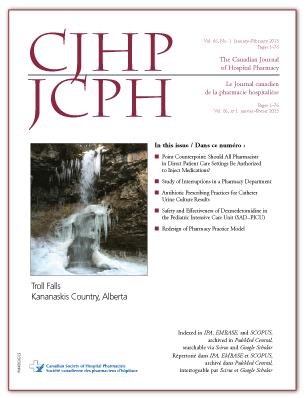Before-and-After Study of Interruptions in a Pharmacy Department
DOI:
https://doi.org/10.4212/cjhp.v66i1.1206Keywords:
hospital pharmacy practice, drug-use process, interruptions, distractions, stimuli, pratique de la pharmacie hospitalière, processus de distribution des médicamentsAbstract
ABSTRACT
Background: Few data exist on interruptions in the drug-use process in hospital pharmacies and their effects on patient care.
Objective: The primary objective was to compare the hourly number of stimuli received and emitted (i.e., generated) by pharmacists and pharmacy technicians before and after implementation of measures intended to reduce interruptions. The secondary objective was to evaluate the impact of the corrective measures on 4 specific stimuli.
Methods: This before-and-after cross-sectional observational study was conducted in the main dispensing area of the pharmacy department of a Canadian university hospital centre. Stimuli received and emitted by pharmacists and pharmacy technicians were counted before (2010) and after (2012) implementation of corrective measures designed to limit interruptions. The effect of corrective measures on targeted stimuli was measured with a t test.
Results: Data were collected during a total of 93 randomly scheduled 30-min observation periods: 62 periods in 2010 (n 2663 stimuli) and 31 periods in 2012 (n = 1217 stimuli). The average hourly stimulus rate (± standard deviation) was unchanged after implementation of corrective measures: 85.9 ± 22.2 in 2010 and 78.5 ± 20.1 in 2012 (p = 0.06). However, a significant decline was observed for many individual stimuli, including the number of face-to-face nonprofessional conversations among pharmacists (4.4 ± 4.2 in 2010 versus 1.2 ± 1.8 in 2012, p = 0.003).
Conclusion: Despite the implementation of corrective measures, there was no statistically significant change in the hourly stimulus rates from 2010 to 2012. Other studies are needed to better characterize the nature and repercussions of stimuli, distractions, and interruptions.
RÉSUMÉ
Contexte : Il existe peu de données sur les interruptions dans le processus de distribution des médicaments au sein des pharmacies d’hôpitaux et de leurs effets sur les soins aux patients.
Objectif : Le principal objectif était de comparer le nombre de stimuli reçus et émis (c.-à-d. engendrés) à l’heure par les pharmaciens et les assistants techniques en pharmacie avant et après la mise en oeuvre de mesures correctives visant à limiter les interruptions. L’objectif secondaire était d’évaluer l’incidence des mesures correctives sur quatre stimuli particuliers.
Méthodes : Il s’agit d’une étude d’observation transversale pré- et post-intervention menée dans la principale aire de distribution du service de pharmacie d’un centre hospitalier universitaire canadien. Les stimuli reçus et émis par les pharmaciens et les assistants techniques en pharmacie ont été comptés avant (2010) et après (2012) la mise en oeuvre de mesures correctives visant à limiter les interruptions. L’effet de ces mesures sur les stimuli ciblés a été mesuré au moyen d’un test t.
Résultats : Les données ont été collectées au cours de 93 périodes d’observation aléatoires de 30 minutes : 62 périodes en 2010 (n = 2663 stimuli) et 31 périodes en 2012 (n = 1217 stimuli). Le taux moyen de stimuli par heure (± l’écart type) est demeuré inchangé après la mise en oeuvre des mesures correctives : 85,9 ± 22,2 en 2010 et 78,5 ± 20,1 en 2012 (p = 0,06). Cependant, plusieurs stimuli ont individuellement baissé de façon significative, dont le nombre de conversations non professionnelles en personne parmi les pharmaciens (4,4 ± 4,2 en 2010 contre 1,2 ± 1,8 en 2012, p = 0,003).
Conclusion : Malgré la mise en oeuvre de mesures correctives, aucun changement statistiquement significatif n’a été observé dans les taux de stimuli par heure entre l’année 2010 et l’année 2012. D’autres études sont nécessaires afin de mieux caractériser la nature et les répercussions des stimuli, des distractions et des interruptions.
Downloads
Published
Issue
Section
License
Copyright © Canadian Society of Healthcare-Systems Pharmacy.
After publication of a manuscript in the CJHP, the authors of the manuscript must obtain written permission from the CSHP (publications@cshp.ca) before reproducing any text, figures, tables, or illustrations from the work in future works of their own. If a submitted manuscript is declined for publication in the CJHP, all said rights shall revert to the authors. Please note that any forms (e.g., preprinted orders and patient intake forms) used by a specific hospital or other health care facility and included as illustrative material with a manuscript are exempt from this copyright transfer. The CJHP will require a letter from the hospital or health care facility granting permission to publish the document(s).










